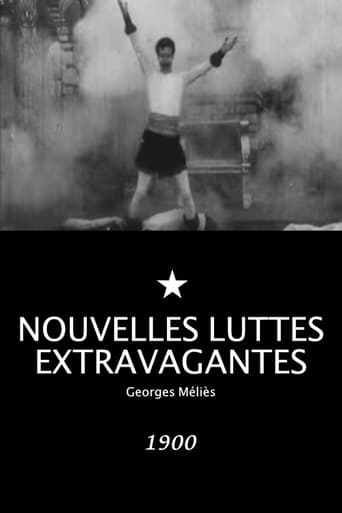Beystiman
It's fun, it's light, [but] it has a hard time when its tries to get heavy.
Rio Hayward
All of these films share one commonality, that being a kind of emotional center that humanizes a cast of monsters.
Cassandra
Story: It's very simple but honestly that is fine.
Aspen Orson
There is definitely an excellent idea hidden in the background of the film. Unfortunately, it's difficult to find it.
framptonhollis
At the very, very beginning of cinema, cinemagician Georges Melies refused to be caught between the boundaries of limit. Despite lack of cinematic technique at the time, Melies worked hard to crate what his imagination desired, and thus, film as an art form significantly developed in the process. This early action-comedy hybrid is a wacky, cartoonish depiction of a manic wrestling match made all the more insane by the constant disappearing, reappearing, morphing, etc. of the wrestlers. Men are torn apart and put back together, they are surrealistically flattened, and keep switching back and forth from being women. it's a ridiculous little movie, and hugely imaginative and impressive for its time, particularly in a visual sense. I was legitimately wow-ed by this film's special effects, even more so than with Melies' other movies. Remember: this movie was made back in 1901, well over 100 years ago, and yet it still is jam packed with some of the most magical cinematic tricks of all time 9not to mention, much of it is still also genuinely funny).
Horst in Translation (filmreviews@web.de)
"The Fat and the Lean Wrestling Match" is a Georges Méliès short film that tells us a but about gender roles around 1900, 115 years ago. Very early, we see two women in fancy dresses and they reappear in this almost 2-minute-long short film, but most of the time we see two men wrestling. But it's more than that. Méliès uses trick photography again to create 3 funny and awkward situations where obviously one of the fighters was a doll used for that particular moment. All in all, it's a solid Méliès film, not among his best. Obviously, this is still black-and-white and silent, even if there are versions out there where people used soundtracks. Not that great too watch though except the scenes where the master used the trick photography I mentioned before.
tavm
We see two women covering themselves with blankets. When they uncover themselves, they are now two men. These two men start to wrestle. One of them manages to throw the other around. The other one then literally knocks his head off as well as his arms, legs, and feet! He then puts the dismembered parts together when he places the body together on the bench. The women come back to take the men away from the screen. Two different men appear who are much bigger. The bigger of the big manages to flatten the other one like a pancake. After the flattened one comes back to normal, he throws the other one up before that other one lands back on him! They wrestle a little before the less heavy of the big men manages to pin him down and jump on him, causing his arms, legs, and head to disassemble on impact! After he leaves, the disassembled man assembles and walks out of screen. The end. It is here that Georges Melies takes a popular fairground sport and gives it a cartoonish feel on film. It certainly should be fascinating to today's wrestling fans who think wrestling was invented only recently!
Snow Leopard
This funny and imaginative Georges Méliès comedy plays off of the popularity of fairgrounds-style wrestling, adding some humorous touches and a good assortment of the kind of special camera effects for which Méliès is so well-remembered. As with so many of his features, he manages to squeeze a lot of material out of a simple premise.As the movie begins, the wrestlers are two women, but they are only the prelude. The 'main event' features two men wrestling, with some moves and mishaps that you could normally only see in a cartoon. It bears watching closely to notice all of the visual effects that Méliès slipped in, because they go past pretty quickly at times.The camera tricks are quite good for 1900, and show both skill and imagination, in the ideas and in carrying them off. There are only a small handful of times when the illusion does not quite come off, and most of it still holds up pretty well even now.

